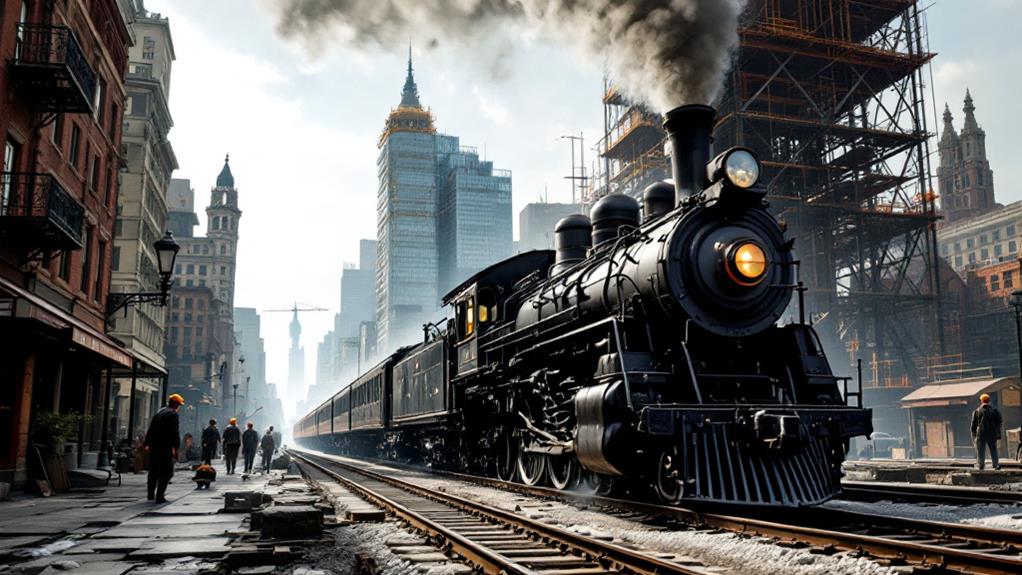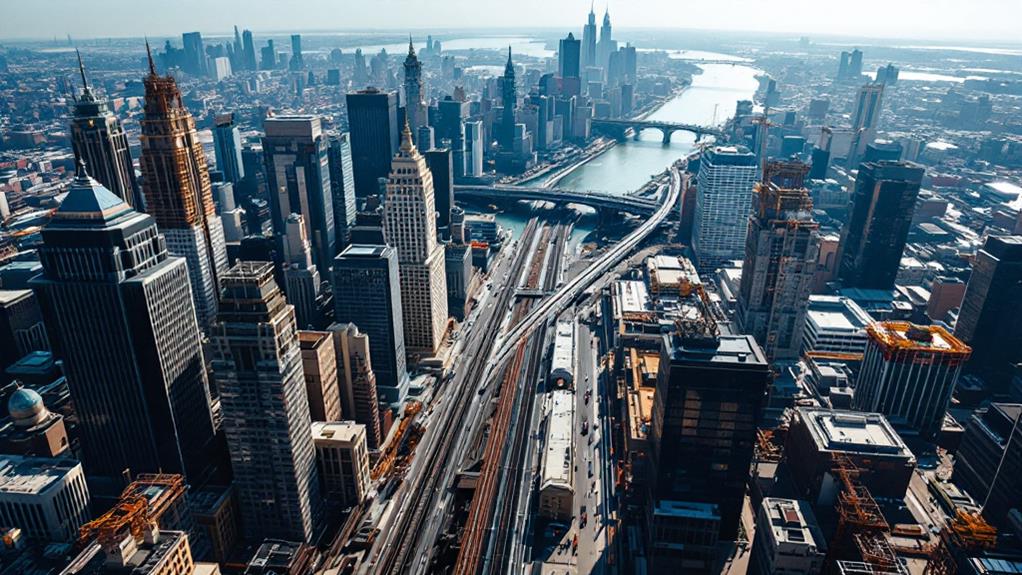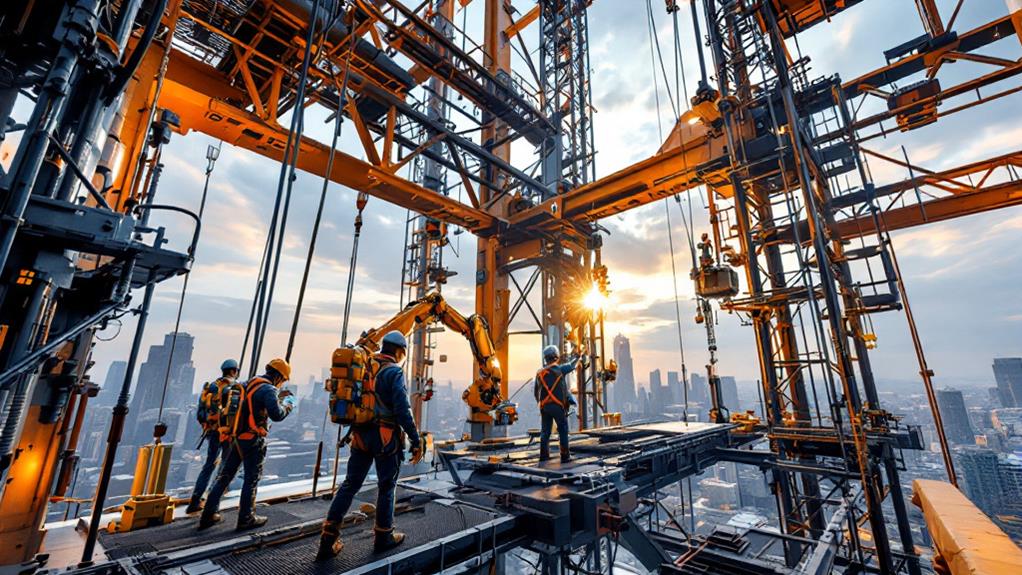A History of Steel Usage in America: From Railroads to Skyscrapers

Steel has revolutionized America since the mid-19th century. You'll find its impact in the expansion of railroads, connecting the nation with durable tracks and powerful locomotives. In cities, steel enabled the rise of skyscrapers, reshaping urban environments with towering structures. During World Wars, it fueled America's industrial might, producing tanks, ships, and weapons. Today, steel continues to innovate, with lightweight frames and advanced fabrication techniques redefining construction. From the industrial titans like Andrew Carnegie to modern designers pushing boundaries, steel's versatility and strength have been crucial in shaping America's infrastructure and global influence. The full story of steel's evolution is even more fascinating.
The Birth of American Steel
Steel kicked off its American expedition in the mid-19th century, altering the nation's industrial terrain. As you immerse into this era, you'll uncover that the Bessemer process, introduced in 1856, revolutionized steel production methods. This innovative technique allowed for mass production of steel at substantially lower costs, igniting rapid growth of the steel industry across the nation.
You'll find that steel's versatility and strength quickly made it indispensable in various sectors. Railroads, in particular, benefited immensely from steel's durability, enabling the expansion of America's transportation network. As steel production soared, you'd witness the rise of industrial titans like Andrew Carnegie, who built empires on the foundation of this transformative material.
The growth of the steel industry wasn't just about production; it reshaped entire communities. Steel towns sprouted across the landscape, attracting workers and cultivating economic development. You'd observe how steel's influence extended beyond manufacturing, influencing architecture, infrastructure, and even warfare. This period marked the beginning of America's ascent as a global industrial powerhouse, with steel at its core.
Railroads: Connecting a Nation
As you trace the steel tracks across America's expansive terrain, you'll find that railroads played a crucial role in the nation's development. The expansion of the railway system in the 19th century transformed the nation's steel infrastructure, connecting distant cities and nurturing economic growth.
Steel's durability and strength made it the ideal material for railroad construction. You'll notice how it revolutionized the industry, allowing for:
- Longer, more stable tracks
- Stronger bridges and trestles
- Heavier, more powerful locomotives
These advancements led to faster, more efficient transportation of goods and people. You'll see how locomotive innovations, such as steel boilers and wheels, improved speed and safety. Steel's impact on railroads wasn't limited to the tracks and engines; it also transformed the cars themselves, making them sturdier and more comfortable for passengers.
As you investigate America's railway history, you'll uncover how steel enabled the transcontinental railroad, connecting the East and West coasts. This monumental achievement spurred further industrial growth, opening up new markets and facilitating westward expansion. The railroad boom created a symbiotic relationship with the steel industry, driving demand and spurring technological advancements that would shape America's future.
Steel's Role in Urban Development

The rise of urban centers in America owes much to the versatility and strength of steel. As cities grew, you'd see steel's impact on city planning become increasingly evident. It allowed for taller buildings, wider bridges, and more extensive transportation networks.
Steel's role in architectural design revolutionized the way cities looked and functioned. You'd notice skyscrapers reaching unprecedented heights, transforming city skylines. These towering structures weren't just architectural marvels; they were practical solutions to the growing demand for office and living space in crowded urban areas.
Steel's strength-to-weight ratio made it possible to construct buildings with larger open spaces and fewer support columns. This flexibility in design opened up new possibilities for urban planners and designers. You'd find steel in the framework of department stores, theaters, and public buildings, allowing for grander, more open interiors.
Moreover, steel's durability and fire resistance made it an ideal material for urban construction. It helped create safer, more resilient cities that could withstand natural disasters and the test of time. Steel's influence on urban development has been profound, shaping the modern American cityscape you see today.
World Wars and Industrial Might
When global conflicts broke out in the 20th century, America's steel industry stepped up to the plate. You'd find steel at the heart of the nation's military production, powering the industrial revolution that transformed the United States into a global superpower. As you look back, you'll see how steel became the backbone of America's war effort during both World Wars.
During these conflicts, you'd witness the steel industry's rapid expansion and technological advancements. The demand for steel skyrocketed, leading to unparalleled production levels. You'd see factories working around the clock, churning out:
- Tanks, ships, and aircraft
- Weapons and ammunition
- Infrastructure for military bases and supply chains
You'd notice how this industrial might not only helped win the wars but also positioned America as a global economic leader in the post-war era. The steel industry's ability to rapidly scale up production and innovate under pressure proved essential. As you examine this period, you'll understand how steel played a formative role in shaping America's military and economic dominance throughout the 20th century.
Modern Innovations in Steel Construction

From the skyscrapers that define city skylines to the bridges that span vast waterways, modern innovations in steel construction continue to expand, broaden, or extend the limits of what's possible. You'll find that lightweight steel frames have revolutionized building design, allowing for taller structures with less material. These frames provide strength without excessive weight, enabling the designer to push boundaries and create more daring designs.
Sustainability in steel design has become a vital focus in recent years. You'll see this reflected in the increased use of recycled steel and the development of more energy-efficient production methods. Engineers are now designing buildings with steel components that can be easily disassembled and reused, reducing waste and environmental impact.
Advanced computer modeling and 3D printing technologies have also transformed steel construction. You can now witness complex steel structures being fabricated with unparalleled precision. These innovations allow for faster construction times, reduced costs, and improved safety standards. As you look around modern cities, you'll notice how these advancements have shaped the urban landscape, creating more resilient and adaptable structures that can withstand natural disasters and changing environmental conditions.



